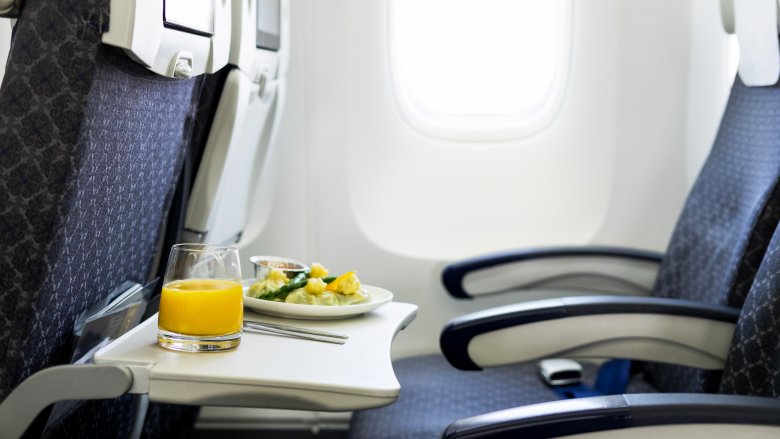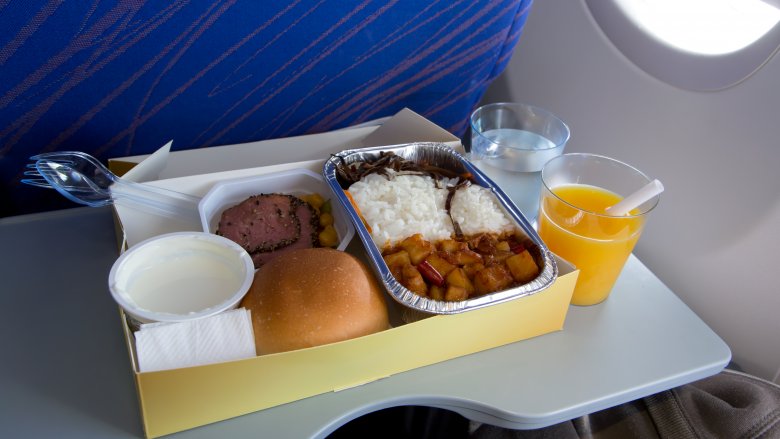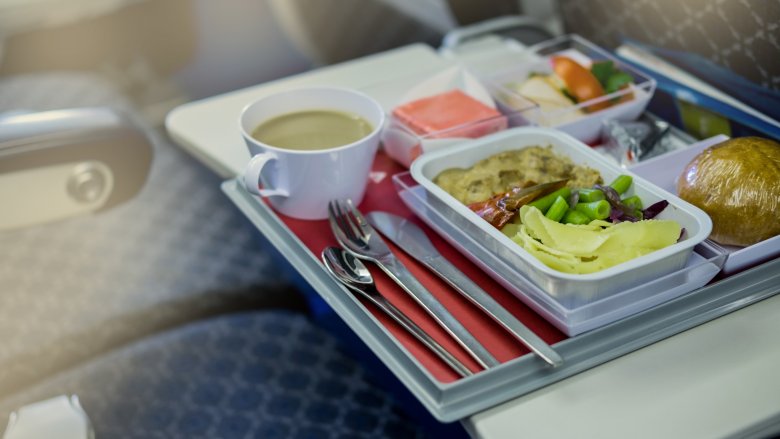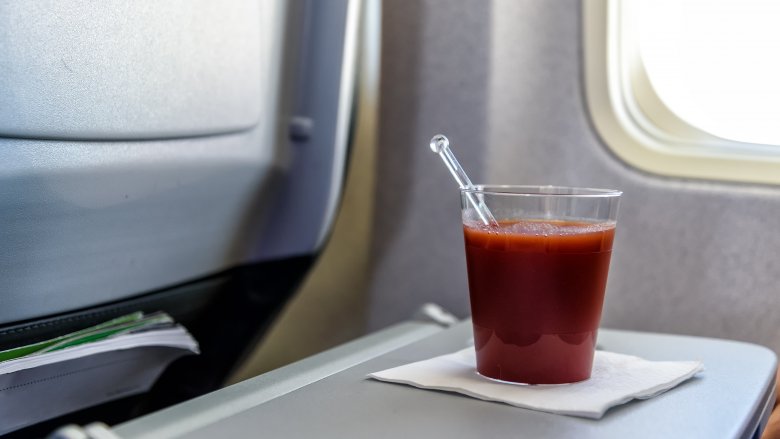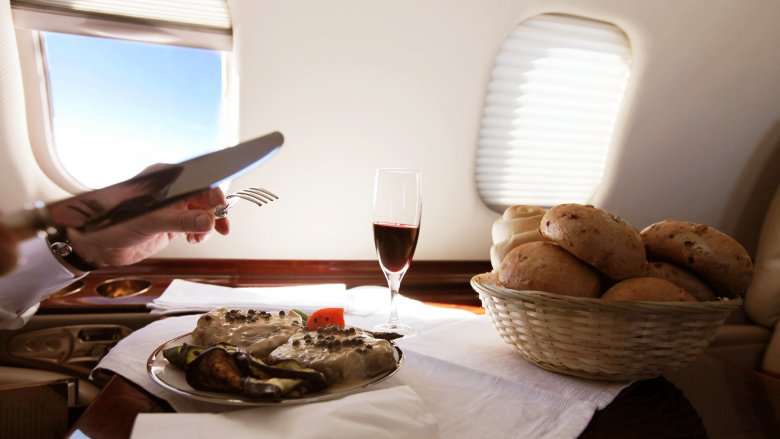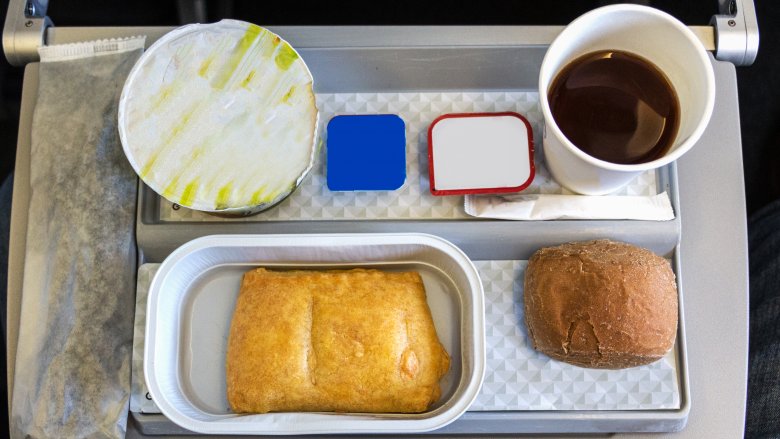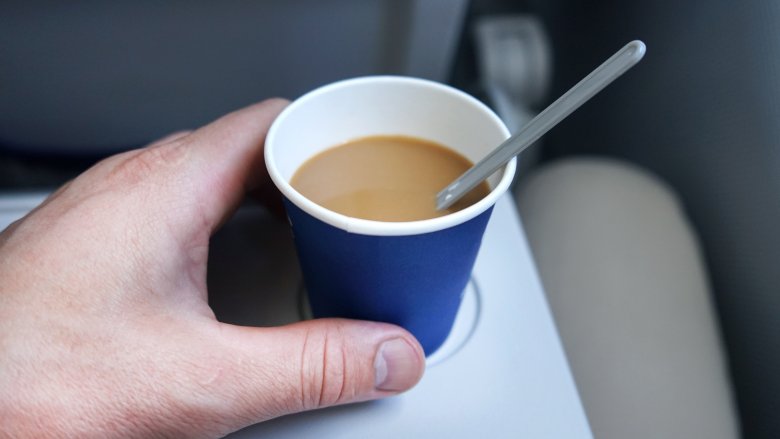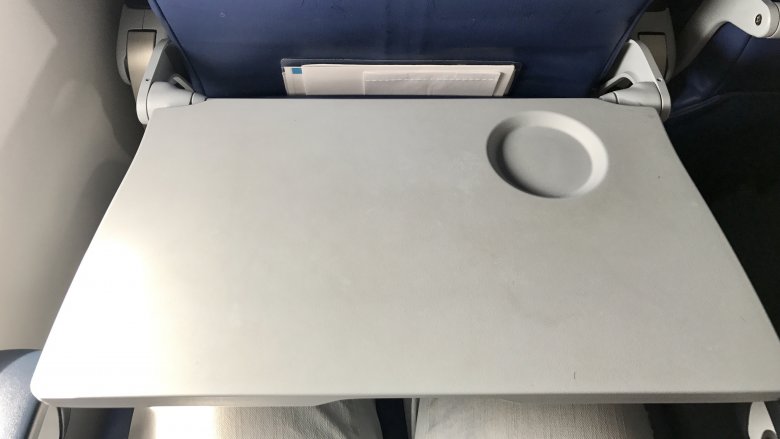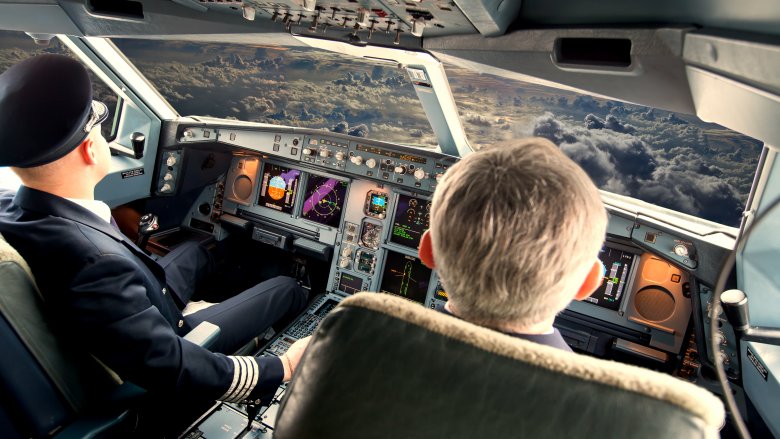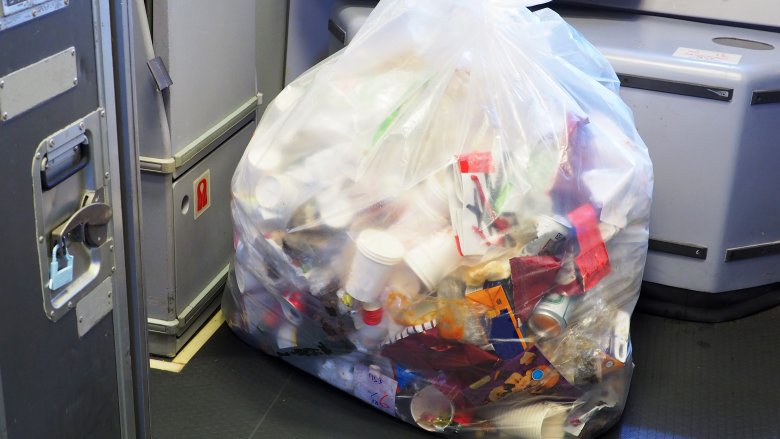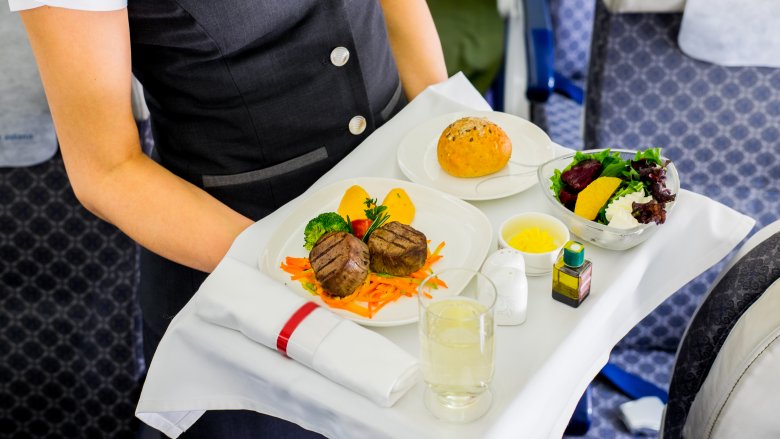The Truth About Your Airplane Meal
Mention plane food to a group of travellers and you'll likely hear a chorus of "ew," "gross," and "I'd rather starve." It is true, for the most part, that airline meals leave something to be desired. Those plastic-wrapped trays featuring a dried-out chicken breast doused in gravy, accompanied by mixed veggies and rice aren't exactly what most would call a gourmet meal. Let's be honest — the buttered roll is usually the star of the show. But what if we told you that the blame doesn't lie solely on the food itself? Turns out there's a reason your airplane dinner tastes a little off, why your wine makes you pucker, and why you have that inexplicable need for tomato juice.
There's a lot more about airplane food you probably don't know. Some things, like the way it's prepared, will surprise you. Other things, like what's on your tray table, will horrify you. Here's everything you ever wanted to know about your in-flight meal. You might want to fasten your seatbelts... things may get a little bumpy.
Food really does taste different in the air
Have you ever felt like your taste buds just aren't functioning quite right at 30,000 feet? It's not your imagination — the in-flight environment impacts the way your food tastes in several ways.
The biggest issue is that flying at high altitudes really does a number on your sense of taste. Even in the comfort of the plane's pressurized cabin, your taste buds become suppressed, which can make food seem bland. Add in low cabin humidity, recycled air, and the ever-present air conditioning, and it's a recipe for disaster. Not only does all that dry air take a toll on the moisture content of the food (hello, dry chicken breast), it also dries out your nose. Your sense of smell is tied to your sense of taste, so that further knocks down your ability to perceive flavors. Even the noise and vibration of the plane can wreak havoc on your ability to taste, as it stimulates a nerve in your middle ear that lessens the intensity of certain flavors.
Yes, it's saltier and sweeter
According to a study commissioned by German airline Lufthansa, "salt is perceived to be between 20 and 30 percent less intense and sugar 15 to 20 percent less intense" while in the air. So how do airlines deal with that seriously suppressed sense of taste? You guessed it — your meals have a lot more salt, and a lot more sugar — up to 30 percent more to be exact. Even certain seasonings and herbs are used with a heavier hand than if you were chowing down on the ground.
"Proper seasoning is key to ensure food tastes good in the air," Russ Brown, director of in-flight dining and retail at American Airlines, told BBC, "Often, recipes are modified with additional salt or seasoning to account for the cabin dining atmosphere." United executive chef Gerry McLoughlin concurred, saying he must use "vibrant flavors and spices" to ensure the in-flight meals are "more robust."
Worried about all that extra salt and sugar? Don't be. Professor Zhou Weibiao, director of the NUS food science and technology program told Men's Health, "Unless people have in-flight meals very frequently, a few meals in a month that are a little heavier won't cause major concern." And they'll taste better, too...
Why do we crave tomato juice?
Ever wonder why you have that undeniable craving for tomato juice on an airplane, even if you'd never drink it otherwise? We can turn to science for the answer: It just tastes better at higher altitudes.
WHYY reports that a test concluded that people overwhelmingly preferred tomato juice in a flight simulator versus on the ground. "We learned that tomato juice being on ground level is rather — I'm not saying moldy, but it tastes earthy, it tastes not overly fresh," said Lufthansa catering executive Ernst Derenthal. "However, as soon as you have it at 30,000 feet, tomato juice shows, let's say, its better side. It shows more acidity, it has some mineralic taste with it, and it's very refreshing."
That's because tomato juice is rich in umami — that fifth elusive flavor after sweet, salty, sour, and bitter — which is actually enhanced by being in the air, unlike sweet and salty which get suppressed. Basically, science is responsible for that second bloody mary you just have to have.
Why do I feel tipsier?
So you've polished off one of those cute little bottles of wine, and it seems like it hit you a bit harder than usual. Is it all in your head?
Dr. Nick Young tells The Telegraph that your head is, in fact, partly to blame — specifically your brain. Due to the pressurized cabin, our "brain may experience a very mild reduction in the amount of oxygen that it is used to," he explains. "This is called 'hypoxia' and is what is much more likely to give you that sensation of being more drunk." Aside from that, Young says that lack of food (because we're all avoiding the dreaded airline meals) and dehydration (thanks to the bone dry cabin air) contribute to the "getting drunk faster" phenomenon.
Okay, so we might be a little tipsy, but did that wine taste off to anyone else? JetBlue confirms that wines "tend to taste more acidic and tannic inside the pressurized environment of an airplane." What works for tomato juice does not necessarily work for red wine.
Bottom line: If you're planning to party at 30,000 feet, do so on a full stomach, drink plenty of fluids, and maybe skip the vino if you're a wine snob.
The top priority isn't taste
When you make 30,000 meals a day for airlines, a food poisoning incident would be catastrophic. And when food safety is king, taste suffers.
Fritz Gross, director of culinary excellence at LSG Sky Chefs Asia Pacific, a catering service that provides meals for several major airlines, told CNN, "Our top concern is actually food safety. Because we do such a large volume, we cannot afford to have things in there that are not right. You can imagine how easily an airline can get sued." You can also imagine a less pleasant visual: The after-effects of a plane full of passengers with food poisoning.
To avoid any risk, foods like medium-rare steaks are simply off the table, he says, but safer options like pasta or chicken suffer when reheated. What dish should you opt for, if given the choice? Gross says to always go for the stew. "We can simmer it and reheat it over and over and it will still be a stew," he says. Also on his list of recommendations: Fried rice and fatty fish, which retain moisture well.
Why you should avoid the coffee
Now that we've got chicken and pasta on the "do not eat" list, what about drinks? Bad news, caffeine lovers: It might be best to avoid the coffee and tea that comes out of the galley kitchen.
According to EPA test results obtained by NBC, the drinking water served on airplanes is rife with bacteria. The 2012 data showed that one in 10 planes tested positive for coliform, a bacteria which indicates fecal contamination. While coliform isn't likely to make people sick, it can be an indicator that other bacteria, like E.coli, is present, which can make you ill. And even if it doesn't make you sick, who really wants fecal matter in their coffee?
The contamination occurs when the on-board water tanks are filled with dirty hoses and nozzles, and those water tanks are then used to make your coffee and tea. Moral of the story: Stick to bottled water once you've boarded, and get your caffeine fix — sans poop — at one of the 73 Starbucks conveniently located in the terminal.
Beware the tray table
If you don't already pack disinfecting wipes in your carry-on, you will after you learn what's lurking on your tray table.
That's right — according to Travelmath, who conducted a study of the dirtiest places on airplanes and in airports, the very surface that you eat your in-flight meal off of is teeming with bacteria. In fact, the tray table has about eight times more bacteria per square inch than the plane's lavatory flush button, and also beats out the airport's bathroom stall locks and drinking fountains for the title of germiest spot.
Dr. Charles Gerba, microbiologist at the University of Arizona, told Time that his testing of airplane tray tables has shown "cold viruses, human parainfluenza viruses, norovirus (which can cause diarrhea and vomiting) and the superbug MRSA, which causes skin infections." Aside from a thorough wipe-down, avoid catching any of these bugs by keeping your food on the tray or wrapper it's served in, and not the tray table itself.
Co-pilots don't get the same food
When you're flying at 30,000 feet in what is essentially a ginormous metal death trap, the last thing you want is for both the pilot and co-pilot to become incapacitated due to food poisoning.
But good news — it's not likely to happen thanks to the rule that most airlines follow, which says that those on the flight deck shouldn't eat the same meal. That way, if one of the pilots becomes ill due to the food, the other (presumably unaffected) pilot can take over the aviation duties and avoid that certain fiery death. Some airlines even take it a step further and recommend that their pilots avoid riskier foods, like raw fish, prior to flying. The Telegraph confirmed with a Virgin Atlantic spokesperson who explained, "The captain is responsible for ensuring that, wherever possible, the operating pilots eat different in-flight meals." And in case you're wondering, it pays to be the pilot — they typically get dibs on the first class meal while the co-pilot gets business class eats.
There's a ton of waste
How often do you actually finish your airplane meal? That leftover food has to go somewhere, and according to The Guardian, the International Air Transport Association estimates that in 2016 airline passengers generated 5.2 million tons of waste — a number that is expected to climb to an astounding 10 million tons annually by 2030. Of course, not all of this is food waste, but a large portion of it is, along with the disposable cups, napkins, plates, and trays that the meals are served with.
Apex reports, sadly, that even unopened packages of food, like the plastic-wrapped cookies that come with your in-flight meal, cannot be reused, as it is illegal to repurpose anything on that metal tray. And aside from uneaten portions, other factors are to blame for the waste. According to Business Insider, who toured a United Airlines catering facility, prepared meals cannot sit for more than six to eight hours before boarding a plane. In other words, if a flight is delayed for too long, it could potentially mean a huge amount of food being thrown out.
How they're prepared might surprise you
When it comes to the process of making your airplane meal, you might picture employees sliding trays down an assembly line of huge containers of frozen chicken and frozen veggies, unceremoniously plunking scoops of food into their separate compartments. But that's not how they're made at all.
For starters, airline meals are tested at sea level, and again in the air to see how they fare at higher altitudes. Once dishes are set, a lot of care goes into making them. When Business Insider visited United's catering facility, they learned that it's actually a painstaking process, and nothing is automated. Fresh produce gets delivered several times a day. Fresh veggies are chopped by hand before getting grilled. Meat gets cooked just 30 percent of the way through, to ensure it's not overcooked in the reheating process. Each dish is packed by hand, and trays are arranged just so according to pictorials. Turns out, this is not your standard school cafeteria food. Of course, once the food is on the dry airplane and bumped around by turbulence and reheated in the galley's convection ovens, all bets are off, but when it goes on board it's in great shape.
